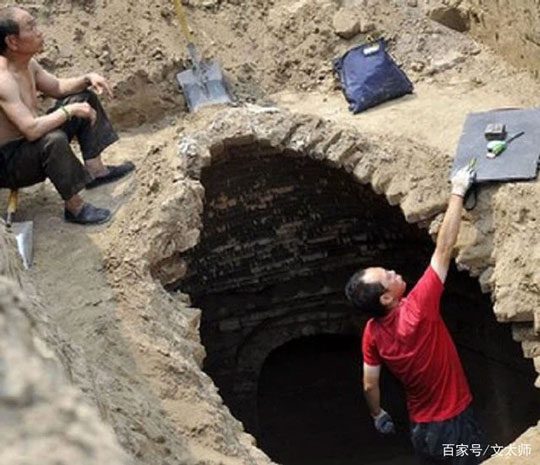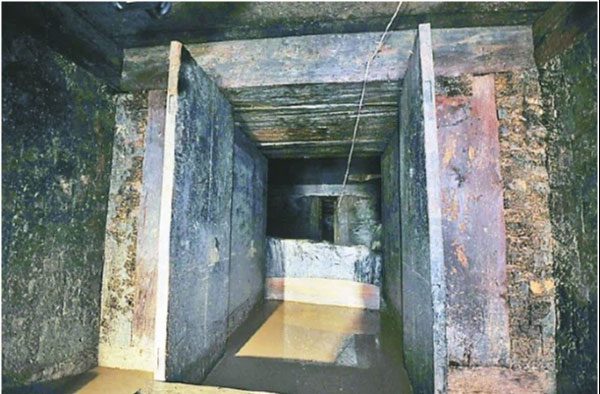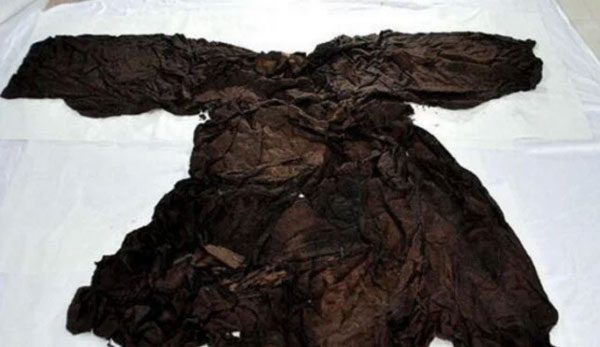Following the scent, experts arrived at the burial site – where a large coffin was placed.
Din Dao District, Shandong Province, China, is a location dating back 4,000 years, concealing many archaeological treasures beneath the ground. The elders in Din Dao passed down stories that there used to be three mounds over 20 meters high, which were said to be blessed by the gods, so no one dared to excavate them, and temples were built on these mounds.
In the 1960s, due to city planning, the temple was demolished, and the mounds were flattened, causing later generations to completely forget about them.

The strange black hole suddenly emanates a fragrance that puzzles archaeologists. Photo: Sohu
In 2010, a black hole suddenly appeared in the area that once was a mound.
This hole was very deep and appeared overnight, leading local residents to speculate that it was a grave robber’s pit created with explosives. Interestingly, those who approached this area could smell a gentle fragrance emanating from the hole.
The archaeological team from the city quickly arrived after receiving reports from the public. After hearing about the mounds and the ancient temple, experts confidently asserted that beneath this hole lay an ancient tomb. But why would a tomb emit a fragrance?
The tomb emanates a fragrance
The archaeological team quickly descended into the black hole to investigate. This tomb spans 900 square meters, and following the scent, the experts immediately understood the situation. The gentle fragrance originated from the coffin’s partition, made from the wood of the agarwood tree.
This is a precious type of wood known for its sturdy, fine texture, yellow color, and especially its natural fragrance. Ancients believed that this type of wood had the power to ward off evil, hence it was named “agarwood” (agar: treasure, wood: place of worship).
 The entrance to the tomb of Empress Dowager Ding. Photo: Sohu
The entrance to the tomb of Empress Dowager Ding. Photo: Sohu
Not everyone could possess an agarwood coffin; this burial method was extremely noble, reserved for emperors or those of noble lineage.
Din Dao was once the fief of seven Ding Dao kings – nobles granted land by the imperial court. Initially, experts believed this tomb was the burial site of Emperor Ai of Han, Liu Huan, one of the Ding Dao kings, who later became the 13th emperor of the Han dynasty.
However, the true owner of the tomb was not Emperor Liu Huan, but his mother – Empress Dowager Ding, whose given name was Ding Ji.
Ding Ji was originally a concubine of King Liu Khang of Din Dao. Later, since Liu Khang’s legitimate wife bore no children, her son ascended to the throne. Although Ding Ji was the biological mother of the king, her status led to many disadvantages.
When Empress Dowager Ding passed away in the 5th year AD, Liu Huan was deeply saddened and built her a tomb with the highest burial method available. Empress Dowager Ding was also dressed in a luxurious jade robe made from thousands of pieces of jade, hoping to preserve her bones, keep the deceased’s body intact, and await the opportunity for rebirth.
 The silk robe over 2000 years old. Photo: Sohu
The silk robe over 2000 years old. Photo: Sohu
However, shortly after Empress Dowager Ding Ji was laid to rest, Wang Mang – a powerful minister who manipulated the Han court, seized the throne and ordered the destruction of Empress Dowager Ding’s tomb.
It is said that when Wang Mang and his troops opened the tomb, flames erupted from within, soaring dozens of meters high, causing the soldiers to fearfully refrain from continuing their excavation. However, many artifacts inside were also consumed by the flames. After the fire was extinguished, Wang Mang still ordered his soldiers to strip the jade clothing from the empress and plunder many burial items from the tomb.
When the archaeological team entered the tomb in 2010, what they found was merely an empty burial chamber along with a coffin and a silk robe hidden in a bamboo tube. According to research, some artifacts in the tomb had indeed been destroyed as mentioned in historical records, while the remaining items had been looted by grave robbers.
At this point, the experts could only lament that they had arrived just a step too late!





















































